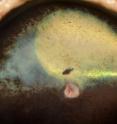Second dose of gene therapy for inherited blindness proves safe in animal studies
Related images
(click to enlarge)
Gene therapy for a severe inherited blindness, which produced dramatic improvements last year in 12 children and young adults who received the treatment in a clinical trial, has cleared another hurdle. The same research team that conducted the human trial now reports that a study in animals has shown that a second injection of genes into the opposite, previously untreated eye is safe and effective, with no signs of interference from unwanted immune reactions following the earlier injection. These new findings suggest that patients who benefit from gene therapy in one eye may experience similar benefits from treatment in the other eye for Leber's congenital amaurosis (LCA), a retinal disease that progresses to total blindness by adulthood. Researchers had exercised caution by treating only one eye in the human trial.
In the current study, the study team found no evidence of toxic side effects in the blood or the eyes of the 10 animals—six dogs and four monkeys—that received the gene therapy. Each animal received an injection first in the right eye, then in the left eye 14 days later. All six dogs, which had been specially bred to have congenital blindness, had improved vision, in addition to showing no toxic effects from the gene therapy.
Researchers from the University of Pennsylvania School of Medicine and The Children's Hospital of Philadelphia, and colleagues from two other institutions published their study today in the journal Science Translational Medicine. The first authors are Defne Amado, of the F.M. Kirby Center for Molecular Ophthalmology at Penn, and Federico Mingozzi, Ph.D., of the Center for Cellular and Molecular Therapeutics at Children's Hospital.
"We designed this study to investigate the immunological consequences of administering the gene therapy injection to the second eye after treating the first one," said corresponding author Jean Bennett, M.D., Ph.D., F.M. Kirby professor of Ophthalmology at Penn. "The good news is that in animals, the second injection, like the first, is benign."
As in the human trials of this gene therapy, the researchers packaged a normal version of the gene that is missing in LCA inside a genetically engineered vector, adeno-associated virus (AAV). The vector delivers the gene to cells in the retina, where the gene produces an enzyme that restores light receptors. Although the virus used does not cause human disease, it previously set off an immune response that cut short the initial benefits of gene therapy, notably in a 2002 human trial of gene therapy for the bleeding disorder hemophilia.
"Our current study in large animals provides encouraging indications that immune responses will not interfere with human gene therapy in both eyes," said co-author Katherine A. High, M.D., a pioneer in gene therapy who helped lead the hemophilia trial. "Like humans, monkeys generate neutralizing antibodies against both naturally occurring and injected AAV, but these antibodies did not prevent the injected gene from producing the desired enzyme." High is director of the Center for Cellular and Molecular Therapeutics (CCMT) at Children's Hospital, which manufactured the vector used in the current study and the previous human trial for LCA.
In the human trial for LCA reported last year, the CHOP/Penn researchers, led by Bennett, High and retina specialist Albert M. Maguire, M.D., associate professor of Opthalmology at Penn, injected the vector into only one eye in each of their 12 patients. Because the treatment was experimental, researchers left one eye untreated in the event of unexpected complications. After the subjects experienced partially restored eyesight in their treated eyes, many were eager to receive the same treatment in the other eye. The current study advances that possibility, and the research team is planning another clinical trial of LCA gene therapy, which may include some of the subjects from the first group.
Additionally, the results may set the stage for gene therapy in LCA patients who were excluded from the previous trial. Adopting a conservative approach, the researchers did not treat patients who already had neutralizing antibodies against AAV in their blood. As many as a quarter of all people may carry these antibodies by their teenage and young adult years. Fortunately, unlike other organs, both human and animal eyes are insulated from these circulating antibodies. (Co-author Stephen Orlin, M.D., of Penn's Scheie Eye Institute, led studies of human samples and showed that even when antibodies to AAV were at high levels in the blood, antibodies within the eye remained at or near background levels). The authors conclude that the presence of those antibodies in the blood will most likely not prevent effective gene transfer in human eyes.
Funding support came from the CCMT, the Foundation Fighting Blindness sponsored CHOP-PENN Pediatric Center for Retinal Degenerations, the National Institutes of Health, Research to Prevent Blindness, Hope for Vision, the Paul and Evanina Mackall Foundation Trust at the Scheie Eye Institute, and the F.M. Kirby Foundation. Dr. High is an Investigator of the Howard Hughes Medical Institute, which also provided support.
Source: University of Pennsylvania School of Medicine
Other sources
- Second dose of gene therapy for inherited blindness proves safe in animal studiesfrom Science DailyThu, 4 Mar 2010, 4:35:17 UTC
- Second dose of gene therapy for inherited blindness proves safe in animal studiesfrom PhysorgWed, 3 Mar 2010, 19:56:36 UTC
